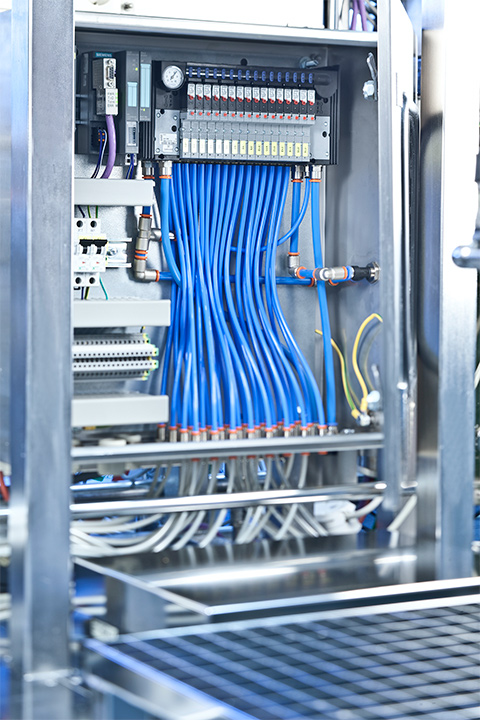
Posted to News on 19th Oct 2022, 15:00
Transitioning to digital makes sense in food and beverage operations

Kieran Bennett, Bürkert’s industry manager for food, beverage, chemical and petrochemical, explains why the transition to digital communications is easier than you think.
For food and beverage production, digital communications from field devices can provide a wealth of data to increase efficiency and productivity that can’t be achieved using analogue signals. However, the perception of high cost and complexity can be an obstacle to implementation. Providing you already use a PLC, upgrading your system with digital communications can enable simpler management and reduced costs in the long-term.
In today’s food and beverage sector, even relatively small sites such as microbreweries use PLCs (programmable logic controllers) to manage their operations. While PLCs are based on digital communications, at the field device level, many networks still rely on analogue communications.
For systems like this, from the control of steam temperature to liquid flow rate, the PLC sends analogue signals to field devices, such as valves and sensors, that return signals as required, also via analogue communications. Meanwhile, the PLC communicates with the human machine interface (HMI) via Ethernet-based, digital signals.
Reducing cost and complexity
To enable analogue communication, additional output and input (I/O) modules that convert digital signals to analogue and vice versa, are added to a PLC. Each analogue-enabled field device requires its own I/O module, adding cost incrementally. While existing users have already invested, expansion to the system will increase the cost burden.
Alternatively, digital communication reduces costs in the long-term. Taking a new installation, with a Siemens PLC and six field devices connected via analogue I/O modules, nearly £1,000 can be saved in hardware by converting the network to industrial Ethernet. For existing systems, multiple new devices can be added at no extra cost once the initial, modest investment for an industrial Ethernet gateway has been made – with no extra PLC vendor licencing costs to add.
Connecting devices via digital communications is also far simpler to manage compared to traditional analogue connections, saving time and costs for wiring and commissioning.
Operational advantages
Even if you don’t immediately plan to add devices, transitioning to digital communications enables significant operational improvements as a result of improved data availability. Unlike their analogue counterparts, information from digital devices can be logged and analysed to optimise the process. This can achieve cost savings, productivity improvements, and higher product quality. The data from digital devices is also more reliable compared to analogue, with higher measurement accuracy and repeatability.
Data communicated by digital sensors is also crucial to improve maintenance and minimise downtime. Diagnostic data, as well as information such as the total number of lifetime cycles, can be used to plan preventative maintenance, lowering the prospect of breakdown. Instead, using analogue devices, the alternative is reacting to faults, as well as the prospect of downtime for repair and replacement.
Simple conversion
Converting to digital communications can be as simple as adding a fieldbus gateway in connection between an existing PLC, Ethernet-ready mass flow controllers (MFCs) and sensors. This removes the cost and complexity of the PLC’s multiple analogue I/O modules, replacing them instead with a single gateway device, like the Bürkert ME43. A single gateway can connect up to 256 inputs, all with licence-free integration.
The ME43 communicates with the PLC via the vendor-specified protocol, while supporting digital communications with field devices through the reliable Bürkert EDIP (Efficient Device Integration Platform) network. EDIP is based on CANopen, the industrial communication protocol used in millions of cars around the world.
An alternative is to use the IO-Link protocol, although the IO-Link master gateway can only integrate a maximum of eight devices. Of course, you can integrate field devices directly compatible with your choice of PLC vendor without using a gateway. However, this adds a significant licence cost per device, and in reality, doesn’t add a practical performance benefit.
Gradual transition
It’s also possible to interoperate field devices with a mix of analogue, fieldbus and digital communications. Adding an ME44 module to the ME43 fieldbus gateway integrates analogue I/O alongside digital. As a result, you can gradually transition your field devices from analogue to digital as they reach the end of their service life.
To immediately transition without the cost of replacing valves, you can convert them to digital-compatible communications. Bürkert’s 8681 control head acts as an adaptor to convert third-party actuators for integration with various Ethernet protocols, saving significant cost, especially for applications with high valve counts.
However the transition is managed, digitally connected devices will provide a cost payback over time. Most significantly, the information they provide will create a more profitable and efficient operation for the future.
Want the latest machine building news straight to your inbox? Become a MachineBuilding member for free today >>
Fluid Control Centre
1 Bridge End
GL7 1QY
UNITED KINGDOM
+44 (0)1285 648720















